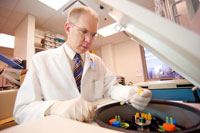Office of Research & Development |
 |


The humble mouse has a lionlike reputation in medical research.
Mice are widely used in labs for a number of reasons. They share many genes and molecular pathways with humans, and they are easy and inexpensive to breed, handle, and genetically engineer. There are fewer ethical and practical concerns than with larger animal species.
One shining example of how mouse studies are relevant to human disease comes from Harvard researcher Pier Paolo Pandolfi, MD, PhD. His work led to a breakthrough in the treatment of a type of leukemia known as APL. Until recently, it was almost always fatal. Now, most patients are completely cured.
On the other hand, mice can often be poor predictors of medical outcomes in people. Scientists met last year at a European Commission workshop to discuss the issue. Their report noted the following: "Mice are not always reliable as preclinical models for human disease, and the scientific literature is littered with examples of drugs that worked well in animals but turned out to be ineffective in clinical trials on humans."
A recent VA lab study, presented at the Gerontological Society of America annual meeting in Boston, offers an interesting example of how mouse and human biology can diverge.
David Canaday, MD, is associate director for research at the Geriatric Research, Education and Clinical Center at the Louis Stokes VA Medical Center in Cleveland. He's also an associate professor in the division of infectious diseases and HIV medicine at Case Western Reserve University.
Among other topics, he studies why some vaccines don't work as well in older adults. What exactly is it about the aging immune system that thwarts a proper response?
His group studied cells from 20 older and 20 younger people. They looked for key differences among proteins that regulate the immune system. Among other findings, they learned that a molecule known as CTLA-4 (for Cytotoxic T-Lymphocyte Antigen 4) was six times more abundant in the cells from the older research volunteers. Another, called PD-1 (short for the cheery moniker Programmed Death 1), was only half as abundant in the older cells.
PD-1 helps dial down the immune response at the proper time by stanching the flow of white blood cells once an infection threat has passed. It's like a military commander yelling, "Hold your fire!" If PD-1 levels sag, an immune response could go on too long. This, says Canady, can result in "pathology, such as scarring of lung tissue."
The researchers were somewhat surprised by the PD-1 finding. In their study abstract, they noted that the result was in "direct contrast to the aging mouse model data." They said the work underscored the "importance of generating data in aging human populations in addition to animal models." Otherwise, researchers could be misled and plan clinical trials that are not as well-founded as they seem.
Canaday points to another area in which mice differ from people in ways that are critical for biomedical research: "Some pathogens don't infect mice very well, and tuberculosis is one of them," he says. "Mice don't get this disease in the wild. In the lab, we can make them get TB, but if you look at their tissues, they don't respond quite the same way. In people, you get granulomas," or nodules of inflamed tissue. "In the mouse, you don't. Most mice die of TB. Most humans recover. That's a huge difference right there."
While they may sometimes seem unpredictable, Canaday says the biological differences between mice and humans occur according to a scientific principle: "It depends on the level you're looking at. If you're looking at the fundamental biology of how DNA is synthesized, or protein signals in the cell, the parallels are really tight. But the further you go to the organism level, the more likely it is there will be variance. So it is important on that macro level to do human studies."
Christopher Austin, MD, senior adviser for translation research at the National Human Genome Research Institute, put it succinctly a few years ago when he told the Associated Press: "These mice are not going to tell us everything, and sometimes they tell us nothing. But as a starting point, mice play a central role."
Canaday couldn't agree more. "I've tried to do basic research mostly in humans"—for example, using human tissue samples from biopsies or swabs—"but there's a limit to what you can do. The animal studies are invaluable. We want to get our clues from animals and then move to humans."
Providing for a smoother, more predictable path from mouse to human studies is now a major goal of scientists worldwide. One key effort is the International Mouse Phenotyping Consortium, which aims to "knock out," or deactivate, one gene at a time in mice and describe what happens physically, biochemically, and behaviorally. Among the measures recommended at the European workshop mentioned above were more training for "mouse pathologists," and increased education for "human pathologists and clinicians to increase their understanding of the opportunities and limitations of mouse models."